Bavaria and Beyond
The frequent flier points were burning a hole in my pocket. It was fall, and I desperately wanted to get away. My husband Fred and I had long wanted to visit Umbria, Italy, and I had found a few rentals that looked promising. We happily anticipated a few weeks wandering through the Umbrian hill towns. But, to my chagrin, we were unable to find a flight to Italy for which we could exchange our frequent flier points. Sensing my frustration, one helpful airline employee suggested we go to Munich. I made a snap decision, and soon had reservations to Germany.
Our disappointment was short-lived and we quickly warmed up to the idea of being in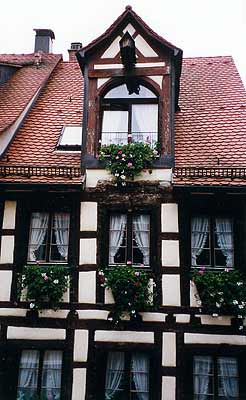 Bavaria during Oktoberfest. In mid-October when we were on our way, we learned, however, that we wouldn’t be there for Oktoberfest after all. The celebration is held from mid-September until the first Sunday of October.
Bavaria during Oktoberfest. In mid-October when we were on our way, we learned, however, that we wouldn’t be there for Oktoberfest after all. The celebration is held from mid-September until the first Sunday of October.
We decided to travel by train, but first spent our first two days in Munich acclimating ourselves to German customs before heading out. Our simple hotel was within walking distance of Marienplatz, the main square, and site of the famous Glockenspiel. Exhausted, we first took a nap under a cozy eiderdown quilt.
Also close to our hotel was the celebrated beer hall, Hofbrauhaus. The loud drunken patrons who rolled out onto the streets interrupting our nap earlier should have deterred us, but we stopped for beer anyway. The large, noisy hall was teeming with tourists and smelled of stale beer and worse, so we found a much quieter beer garden, where we ate a teraditional German meal of sauerbraten with spaetzle.
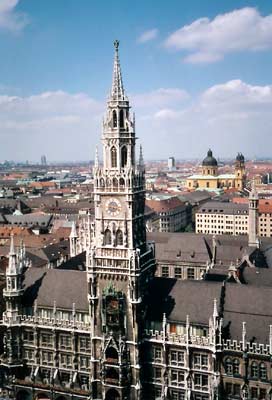
The following day, we arrived at the Marienplatz at noon, just as the Glockenspiel’s colorful carved figures performed their mechanized dance to a chimed tune. We wandered through the nearby Viktualienmarkt, one of Europe's largest food markets, and stopped in a cafeteria-style beer garden for something to eat and drink. While waiting in line I frantically tried to translate the menu with my tourist dictionary, while Fred - more resourceful than I - listened to what others ordered and watched what they received. He repeated what he heard, and we walked away with tasty sausages and cold beers.
The afternoon was spent walking off lunch by strolling and window-shopping along the fashionable streets of the center, open only to pedestrian traffic. We marveled at the grand buildings, then climbed to the top of the bell tower in St. Peterskirche, Munich’s oldest church, for a view of the entire city.
Our next stop was Lindau, a town in a tiny corner of Bavaria on Lake Constance. During the train ride, the weather was foggy and rainy, but as we crossed a causeway onto the island town, the clouds lifted, revealing the snow-capped Alps beyond the lake. After we got a room, we went to the waterfront, with a lighthouse in its colorful harbor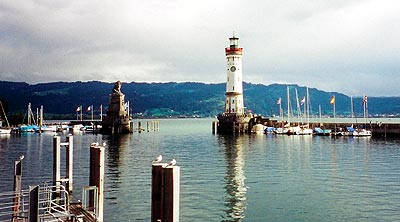
I am naturally drawn to towers in our travels, always anxious to climb high for a bird’s eye view, an inclination not shared by my husband. He waited while I headed up the lighthouse steps behind a group of schoolchildren. As we climbed, the children counted the steps, and I counted along with them in German, “Ein, zwei, drei…” The climb to the top yielded wonderful vistas of the town, lake and Alps.
Chic shops lined the pedestrian streets and scattered here and there were artistically decorated fiberglass cows costumed according to each business nearby-a chef cow stood outside a restaurant, an electrician cow in front of a lamp shop, etc. The afternoon quickly passed with our game of trying to find the next cow and figuring out what business it represented.
The following day we took a boat to Meersburg, a town on the north shore of Lake Constance, which was not accessible by train. Unfortunately, it was raining and we could barely make out the shoreline. But the town of Meersburg was beautiful, perched on a rocky cliff along the lake. Vineyards and orchards clung to the steep hills flanking the town, resplendent in their fall colors. 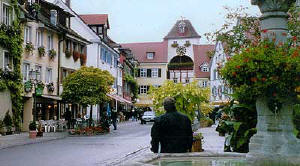
There are two separate parts to the town, Oberstadt, the upper town high on the hill, and Understadt, the lower one along the lake. We found a lovely small hotel near the waterfront, where our third-floor room overlooked a street filled with half-timbered buildings and flowerboxes in every window. We spent the next two days strolling through the picturesque, romantic streets and along the waterfront of the small town admiring the architecture and profusion of flowers and stopped to watch an occasional street performer.
Eventually we climbed the steep street to Oberstadt, stopping at Altes Schloss, a medieval castle, along the way. The 7th century structure boasts a moat and dungeons with the lake mists rising around it like an old Dracula movie. People filled the tiny streets at the top of the town going in and out of the many shops selling handicrafts perfect for filling our shopping bags.
Leaving Meersburg, we took a short ferry ride across the lake to Konstanz, where we could once again pick up the train. Konstanz is literally on the German-Swiss border. Two train stations serve the town: one in Germany, and a few meters beyond, on the same platform, one in Switzerland. We discussed where our next stop would be while we waited in the Swiss station. I picked up a brochure for nearby Stein am Rhein and decided to head there, calling ahead for a hotel room.
Arriving in Stein, we could see the town on the riverbank opposite the station. We made the short walk over the bridge spanning the Rhine River and soon reached Rathausplatz, the main square. Nearly all of the buildings were painted with intricate and colorful murals enhanced by ornate architectural details. The result was stunning and so picturesque that we had our cameras out of our bags before we had even checked into our hotel which, to our delight, was in one of these lovely buildings. We learned that some of these frescoes are nearly 500 years old, yet are remarkably well preserved. Our day was spent exploring the streets and sights of Stein with a stroll along the river and a stop for refreshments at an outdoor beer garden.
Waking to another rainy day, we decided to make a long trip north to Heidelberg. There were a few possible routes that would get us to our destination, so I asked at the information desk which train to take. The friendly German advised us to take the slightly longer route through the Black Forest. He assured us we wouldn’t regret the extra time. He was right. We nearly got whiplash trying to see out both sides of the train, not wanting to miss a thing as we rode through the mountains and lush green valleys dotted with quaint villages. Even in the rain, the views were wonderful. Our seats were spacious and comfortable, and as we relaxed and enjoyed the scenery, a waiter took our lunch order, delivering it to us from the dining car. I couldn’t imagine a more luxurious travel day.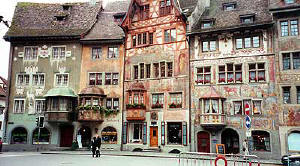
Heidelberg was a larger city than expected. We got a room at a charming antique-filled hotel, overlooking a landmark bridge on the Neckar River. Fred nicknamed the bridge “salt and pepper shakers,” which seemed an apt description. The lively center of the city is closed to vehicles, and the streets were filled with tourists as well as young students, in this big university town. The highlight of our stay was a trip to a large imposing castle high above the town. The beautiful gothic-renaissance fortress is reached by taking a funicular, a steep railway car, up the the mountain from the city center. Partially destroyed in the 1600s, the ruins were covered with vines, brilliant in their autumn colors. The grounds and terraces around the castle provided lovely views of the city and river below.
Our vacation more than half over, we needed to start heading back toward Munich. Our next stop was Rothenburg ob der Tauber, slightly off the main train line, but we had been told that the storybook town surrounded by walls and turrets was worth a visit. The tourist office located a room for us in the town’s center, which we stopped in only long enough to drop our suitcases and grab extra film. Locating a sidewalk café for refreshments, we sat and watched as men dressed in ancient military garb began rolling cannons down the street. Our server told us there was to be a re-enactment of the 17th century battle against the invading Swedes. Sure enough, as we sat sipping our beers, cannons were fired back and forth in front of us.
We strolled the streets with more half-timbered, flower-adorned buildings than we had previously seen. Each of the establishments had intricately fashioned brass or gilded signs hanging outside, lending them old-fashioned charm. The large main square had a clock tower with closed shutters that opened at the stroke of the hour. Mechanical figures revealed by the open shutters acted out “Meister Trunk,” a drinking scene, which depicts the town legend. According to folklore, the town was saved during the Thirty Years War when its mayor won a bet by gulping down three liters of wine. Literally translated, “Meister Trunk” means “master drunk.” That is apparently Rothenburg’s main claim to fame.
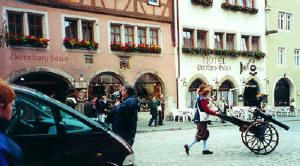
The next day, a brass band was setting up to play in the main square. After a hearty German breakfast in our hotel we sat, a small crowd of us, on the spacious steps of the town hall to listen to traditional German music. We then walked beyond one of the town’s towered gates, where we found a pleasant park with good views of the walled-in town and valley below. There we were entertained by a violinist, trying to eek out a few euros from the listeners.
Later we visited an interesting toy museum, then returned to the main square, where we saw that the entertainment had changed. There was now a trio playing, two having stringed instruments which were unfamiliar to us, and a xylophonist who was extremely talented. The music was lively, and the crowd had grown. Suddenly, the musicians halted. All eyes in the square turned upward to the clock tower to watch the figures act out their routine; the musicians resumed playing after the shutters closed. As the day progressed, new musical groups took over in the square, each placing their instrument cases open to allow the tourists to throw in a few Euros. We spent the rest of the day listening to the entertainment in the square.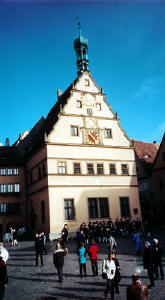
The next morning, we took the train south along the “Romantic Road” through Western Bavaria. Our destination was Nordlingen, another attractive walled-in town, but much less touristy. Finding an inviting bed and breakfast above a restaurant near the town center, we walked on the old wall surrounding it, reachable by stairways at its five gates. Around us were panoramic views of the town, with an occasional glimpse of the surrounding countryside. I was amazed to see that there were apartments within the walls themselves, and futilely hoped for a chance to look inside one.
We orientated ourselves by the town’s central 15th century gothic church, one of the tallest in Germany. The town had a few intriguing museums which unfortunately were closed on Mondays. But I spent much of the afternoon exploring shops selling local goods while Fred sat and people-watched at a sidewalk café. 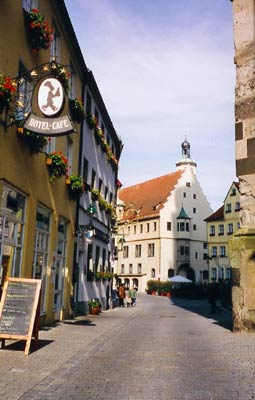
Late in the afternoon we returned to our hotel room, where the aromas coming from the restaurant below made it easy to decide where to eat dinner. We had delicious home-cooked food with a Bavarian flare. Fred bravely ordered wild boar, the house specialty, while I stuck to the more conventional roast pork.
We awoke to a crisp cold autumn morning, and we almost hated to get out from beneath the comfy down quilt. It was now late in October, and we could feel the approaching winter. We continued to head south and entered the Bavarian Alps. When we reached Mittenwald, our final destination, I first noticed the absence of flowers in the window boxes of the pretty town then realized that the leaves were off the trees. The town was nestled among snow-capped mountains and its houses were all mountain chalets. We found a quiet guesthouse near the edge of town, where our room had a balcony with magnificent scenery all around. We spent the day just taking in the sights around town, every view with a backdrop of snowy peaks in the distance. 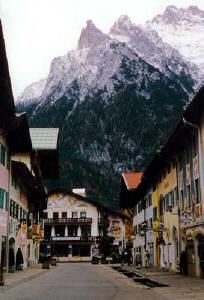
Late in the day we settled into a warm, friendly tavern, which was the headquarters of the local yodeling club. At one large table sat a group of men in traditional Bavarian lederhosen, much like the men in the pictures on the walls. Many pitchers of beer sat on the table, and the mood was jovial. We felt they would break into song at any minute. After another hearty, delicious Bavarian meal, we returned to our room and grabbed the down quilt from the bed to bundle up on the balcony while sipping a local berry liqueur. A full moon illuminated the mountains as we contentedly reflected on the past two weeks, glad that fate had brought us to this beautiful country. We knew that we would someday return.
